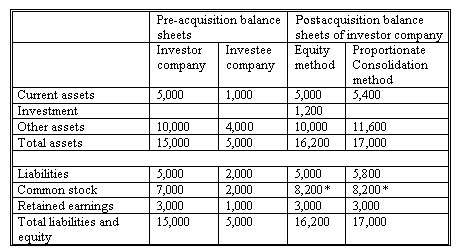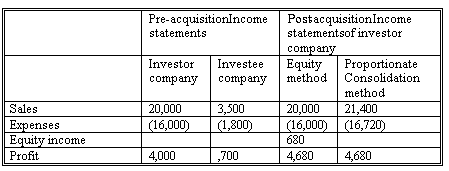- CFA Exams
- 2026 Level II
- Topic 3. Financial Statement Analysis
- Learning Module 10. Intercorporate Investments
- Subject 4. Joint Ventures
Why should I choose AnalystNotes?
AnalystNotes specializes in helping candidates pass. Period.
Subject 4. Joint Ventures PDF Download
Joint ventures are entities owned and operated by a small group of investors with shared common control. The definition of the joint venture is different under IFRS and U.S. GAAP.


- IFRS defines three types of joint venture: jointly controlled operations, jointly controlled assets, and jointly controlled entities.
- Under US. GAAP the term joint venture refers to a jointly controlled separate entity.
Both IFRS and U.S. GAAP require the equity method of accounting for joint ventures.
The proportionate consolidation method is an alternative to the equity method. It includes the proportional amount of each asset, liability, revenue and expense account of the subsidiary in the corresponding account of the parent. It better reflects the risk and return characteristics of proportionate ownership.
- Balance sheet: Replace investment account with percentage owned of assets and liabilities of investee.
- Income statement: Proportionate sales and expenses of investee reported.
Most financial ratios will change under this method because of the inclusion of additional reported amounts in the various numerators and denominators of the ratios.
Example
Assume the same pre-acquisition balance sheets for the investor and investee company. But instead of acquiring 100% of the outstanding common stock, assume that the investor only acquires 40% of the stock at its book value $1,200 ($3,000 book value of stockholders' equity x 40%). A comparison of the equity and proportionate consolidation methods is as follows:

* $7,000 + $1,200

Subsequent to purchase, the net income reported by the investor company will be the same under both methods. Under the equity method, the investor will report equity income equal to 40% of the net income of the investee company. Its sales and expenses will be unaffected. Under the proportionate consolidation method, the investor's sales and expenses will be increased by 40% of the investee company sales and expenses, yielding the same net income.
The effect on return on equity and its components is as follows:

The table presented above yields the following insights.
- The equity method reports the same profit, but fewer sales, than the proportionate consolidation method. This results in a higher net profit margin. This will always be the case.
- Since net income is the same under both methods and assets are higher under the proportionate consolidation method, ROA will be lower under the proportionate consolidation method as well.
- Return on equity will be the same under both methods since income and equity are the same.
- Leverage will be higher under proportionate consolidation since assets are higher and equity is the same.
- Both the numerator and denominator change. As a result, the effect on total asset turnover is indeterminate.
User Contributed Comments 6
| User | Comment |
|---|---|
| ikaneng | if stake is bought with cash, u reduce the current assets by the cash paid, then add the proportion of investee current assets (19000 - (3000 X 30%) + (5000 X 30%) = 19600. |
| actiger | Huh? Where did you get those numbers from? How did 40% become 30% and 15,000 become 19,000? Are you talking about the question #4? |
| Oksanata | profit of investee company is 1700, not 700 as they stated it with error. |
| jilqnydu | In prop consolidation, why is retained earnings unchanged? |
| davidt876 | ecause the investee's retained earnings get turned into the investor's equity |
| blackyosh1 | when do we use proportional consolidatoin method? |

I was very pleased with your notes and question bank. I especially like the mock exams because it helped to pull everything together.

Martin Rockenfeldt
My Own Flashcard
No flashcard found. Add a private flashcard for the subject.
Add